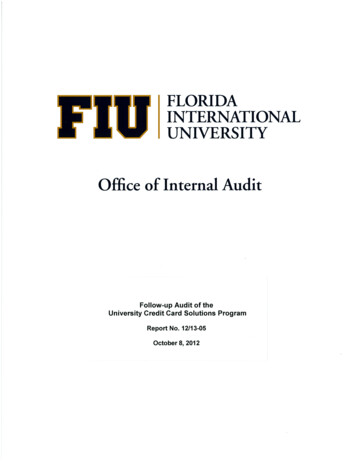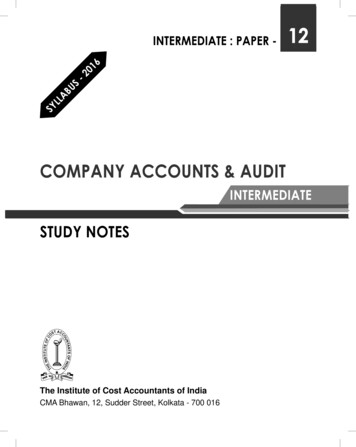
Transcription
OBJECTIVES, SCOPE AND METHODOLOGYPursuant to our approved annual work plan, we have completed a follow-up audit ofProcard/Credit Card Solutions Program; Better Controls & AdministrativePractices Needed, Report No. 09/10-04 dated April 21, 2010. The primary objectivesof our audit were to determine whether: prior audit recommendations have been implemented;established controls, policies and procedures have been effective; andcredit cards transactions are appropriate.The audit was conducted in accordance with the International Standards for theProfessional Practice of Internal Auditing, and included tests of the accounting recordsand such other auditing procedures as we considered necessary under thecircumstances. We reviewed credit card transactions for the period July 1, 2011through February 29, 2012. Audit fieldwork was conducted from May to July 2012.During the audit we: observed and evaluated current practices and processing techniques; interviewed and surveyed personnel; and tested transactions.Sample sizes and transactions selected for testing were determined on a judgmentalbasis.BACKGROUNDThe University’s credit card program was initially developed in 1999 to enable facultyand staff members to efficiently make small dollar purchases. Through the years theUniversity has increased the scope of the program; today the program offers fourtypes of credit cards designed to provide employees with the ability to place orders forcommodities and for the processing of University authorized travel transactions. Theintent of the program is to provide a more efficient means of making routine smallpurchases, which allows more controls at the department level, defrays travelexpenses, and streamlines the procurement cycle. All transactions placed on thesecards must comply with the Credit Card Solutions Program procedures and mustbenefit and support the University’s mission of education, research and public service.The University ended its credit card provider contract with Bank of America andentered into a new contact with J.P. Morgan Chase (Chase) on September 30, 2011.Accordingly, all credit cards issued by Bank of America were cancelled and eachcardholder was required to complete an online cardholder training course and to signa cardholder agreement prior to the new Chase credit card being issued.Page 1 of 5
The Credit Cards Solution Program offers four types of credit cards: Commodity Card: designed to enable cardholders to purchase supplies andservices, with the exception of travel, for their department and/or programs. Theuse of this card is restricted to the individual whose name is on the Card. Thestandard limit assigned to the commodity card is 1,000 for a single transactionand 5,000 monthly. Departmental Travel Card: designed to enable cardholders to purchase onlytravel services for students, non-employees and staff in the department and/orprogram. This card is restricted to only travel related transactions and the use ofthis card is the responsibility of the person whose name is on the card. Thestandard limit assigned to departmental travel cards is 5,000 for a singletransaction and 10,000 monthly. Dual Card: a combination of the commodity and travel cards, the card enablescardholders to purchase supplies, services and travel for their department and/orprograms. The standard limit assigned to the dual card is 5,000 for a singletransaction and 10,000 monthly. Travel and Entertainment (T&E) Card: designed to enable cardholders topurchase University authorized travel and designated entertainment expenses.Unlike other cards, the charges on this card are billed to the cardholder who isresponsible to make full payment to the bank. The cardholder may subsequentlyclaim reimbursement from FIU for authorized and approved charges. The standardlimit for T&E cards is 2,000 for a single transaction and 5,000 monthly.During our prior audit, as of January 31, 2010 1,494 credit cards were outstanding buta concerted effort to reduce the number of outstanding cards succeeded in a decreaseto the 865 credit cards as of June 30, 2012. Expenditures processed through thecards totaled 27 million during the 2011-12 fiscal year.Credit Card Activity As of June 30, 2012Type of Credit CardDepartmental Cards*Number ofCardholdersTotalExpenditures775 26,744,54290323,916865 27,068,458Travel & Entertainment CardTotal* Consist of 467 commodity only, 29 travel only, and 279 dual cardsAlthough a Credit Card Solutions Team (the Team) from the Controller’s Officeoversees the program, the day to day administration of the credit card program is, bydesign, decentralized; transaction execution, review and approvals and documentationare handled by the individual colleges, schools and/or departments.Page 2 of 5
The Controller’s Office and the Team underwent significant changes since our prioraudit. Quality Assurance Services was established to assist the Team with programcompliance reviews, the Team was reorganized and new team members were hired.The current organization structure for the Credit Card Solutions Team is as follows:Page 3 of 5
FINDINGS AND RECOMMENDATIONSOur audit disclosed that the Controller’s Office has significantly improved the creditcard program since our prior audit. The results of our examination indicated that all ofour 11 recommendations were fully implemented, as depicted in the following table:FullyImplementedFindings & indings: Inadequate Administrative Controls1.1- Promptly cancel: (a) unused credit cards, and(b) cards of terminated employees. 1.2- Ensure adequate management oversight ofthe University credit card solutions programadministration. 1.3- Develop and maintain complete logs relatingto cardholder applications, training status andcredit card receipt and distribution dates.1.4- Periodically review and adjust credit cardlimits based on historical cardholder’sspending data.1.5- Reduce the types of cards administered bythe University.1.6- Establish and monitor cardholder approverrelationships based upon a hierarchicalorganizational structure. 1.7- Establish a procedures manual for theUniversity credit card program administration. Findings: Cardholders & Approvers Continue To Circumvent Policies & Procedures2.1- ExpandCreditCardSolutions Administration’s efforts at monitoring thecredit card program.2.2- Ensurethatallcardholdersand reviewers/approvers are periodically retrainedwith an emphasis on the key risks identified.Overall: the Credit Card Solutions Effectiveness3.1- Re-evaluate the effectiveness of the Credit Card Solutions Program and the controls andresources dedicated to adequately carry themout and weigh the costs and benefits of each.3.2- Provide enhanced training to the Credit Card Solutions Team and take advantage ofsystem tools to review transactions.During the audit, we observed that the Controller’s Office actively monitors credit cardsuse and revises limits as needed; cardholders and approvers are informed of creditcard policy violations; and the terminated employees’ credit cards are timely cancelled.Also, program compliance reviews and desk audits were being performed.Nevertheless, due to the decentralized nature of the program and inherent difficultiesadministering the program, some recurrent deficiencies occur.Page 4 of 5
We surveyed 28 cardholders and found the following: 1 (4%) indicated that she shared her card or card information with other staffmembers to make purchases. One of those staff members is also her approver. 2 (7%) indicated that their cards are kept in an office desk or file cabinet accessibleby others. 8 (29%) indicated that their cards are automatically linked to vendor websites tomake online payments quicker.Sharing credit card and credit card information; keeping credit cards in an office deskdrawer or file cabinet; and saving credit card information on vendor websitesdecreases accountability and increases the likelihood of unauthorized or inappropriatepurchases.In addition, we tested 554 credit card transactions, totaling 228,879 and noted thefollowing exceptions: Ten purchases, totaling 862, had no invoice or receipt to support the transaction. Thirty-eight purchases, totaling 28,683, were not signed and dated by thecardholder. Three purchases, totaling 819, made by someone other than the cardholders. Payment for dry cleaning of “work clothes” totaling 71. The Credit Card SolutionsAdministrator confirmed that this is the unallowable/personnel purchase. Three payments for personal cell phone charges totaling 120. A duplicate airline ticket costing 835 was purchased because the cardholdermistakenly processed the online purchase twice. No refund or credit was received. Sales taxes totaling 299 was paid on eight separate transactions.Despite the exceptions noted above, in our opinion, the Controller’s Office has made agreat improvement monitoring and establishing controls over the credit card programsince our prior audit. For example, the number of cardholders is significantly reduced;credit card transactions are continually monitored; cardholders and approvers areregularly trained; and program compliance reviews and desk audits are performed.Therefore, we have no new recommendations at this time.Page 5 of 5
Dual Card: a combination of the commodity and travel cards, the card enables cardholders to purchase supplies, services and travel for their department and/or programs. The standard limit assigned to the dual card is 5,000 for a single transaction and 10,000 monthly. Travel and Entertainment (T&E) Card: designed to enable cardholders to











